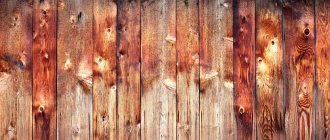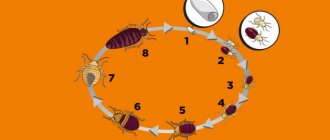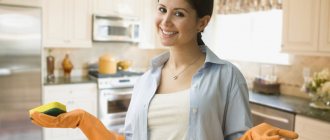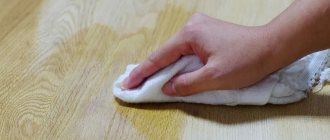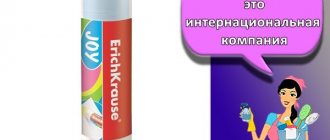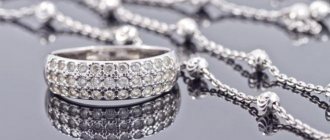This topic will discuss how to disinfect the air and disinfect the premises of the house.
Air disinfection in residential premises is carried out in order to reduce the risk of infectious and viral diseases that are transmitted by airborne droplets and are very dangerous to humans.
The main task of disinfection is to reduce the concentration of harmful microorganisms in the air that cause various ailments, and to increase natural immunity. We will look at how to properly, and most importantly, how to disinfect air at home, in this material.
Preparation
Disinfection should be carried out immediately after the patient has fully recovered. In many ways, the procedure is similar to spring cleaning. It is important to clean absolutely all surfaces. Before disinfection, all children and pets must be removed from the house to eliminate the negative impact of the disinfectant on their bodies.
You should start from the furthest rooms, gradually approaching the bathroom and kitchen. All items must be removed from each room where cleaning is carried out and processed separately. After disinfection, it is recommended to pack them in separate clean bags until the procedure is completely completed. Absolutely everything needs to be processed.
All furniture should be moved from its usual places. It will be possible to return it only after complete processing of both the surfaces hidden behind it and itself. At the same time, you need to take everything out of it in advance in order to disinfect the inside.
What is sanitization of premises?
Disinfection of premises is a safe procedure for humans that reliably eliminates viruses and harmful bacterial pathogens. It allows you to improve the microclimate by eliminating threats invisible to the eye.
This is interesting: the more people pass through the area, the higher the level of pollution. Therefore, in public institutions, especially those of a health nature, disinfection measures must be carried out regularly, in accordance with accepted safety standards.
The active substance used is aimed at destroying toxins and destroying pathogens of infectious diseases that are present on surrounding objects. However, no product provides a 100% guarantee of effectiveness. Absolutely all pathogens cannot be eliminated. There will be a minimal amount left that cannot significantly harm the human body.
How to disinfect an apartment - traditional methods
The most popular means are almost always traditional methods, regardless of the type of cleaning. With their help, you can quickly and effectively disinfect your apartment, getting rid of all germs. There are several most suitable means.
How to disinfect an apartment using natural means - video:
Vinegar
Disinfection with vinegar is quite effective and does not require a lot of money. Getting rid of viruses this way will be very easy.
How to proceed:
- Mix vinegar with water (1 to 2).
- Pour into a spray bottle.
- Spray on all surfaces and wipe them.
The kitchen and bathroom are the best places to use this method. You need to use vinegar to clean everything in these rooms. Particular attention should be paid to the laundry basket. It is allowed to add salt in an amount equal to the volume of vinegar.
Bleaching powder
You can buy bleach at any household stores. It will help quickly disinfect rooms after any illness.
How to make the mixture:
- Stir lime (1 kg) in water (9 l).
- Wipe all surfaces.
This mixture is best for cleaning the toilet and bathroom.
Hydrogen peroxide
A mixture of hydrogen peroxide and water shows maximum effectiveness not in cleaning furniture or surfaces, but in washing clothes. You can also rinse your toothbrush with it.
Application:
- Heat the peroxide mixture (100 g per 12 liters of water) to 60°C.
- Place the laundry in there and boil for 15 minutes.
After this, things can be rinsed with conditioner. They need to be dried only in a disinfected room.
Sun
A very simple and affordable way to disinfect your apartment is the sun. Therefore, all things that can be placed outside (for example, on a balcony) must be taken out into the sun. In a short time, all germs will be destroyed. However, after this, it is recommended to use other folk remedies to eliminate bacteria in places out of reach of the sun.
Tea tree oil
The use of oil is very effective. It can be applied in two ways. They show approximately the same effectiveness and are easy to use. The oil is excellent against fungus.
Methods:
- Place a few drops on cotton balls, place them in the vacuum cleaner's dust container and begin cleaning.
- Dilute a spoonful of oil in a glass of water and spray the mixture with a spray bottle.
These methods can be used to clean both main surfaces and a computer, keyboard, TV or other equipment.
Linseed oil
When cleaning an apartment after illness, you can use linseed oil. It does its job well and is well suited for wooden surfaces.
Method of use:
- Mix with water (1 tablespoon per glass).
- Pour into a spray bottle.
- Apply to surfaces and wipe.
Flaxseed oil is a good antiseptic that can not only disinfect, but also improve the appearance of floors, walls or furniture.
Essential oil
When cleaning an apartment after viruses, you can use various essential oils. A good choice would be lemon, pine or fir. They will help you achieve results quickly.
How to proceed:
- Apply a small amount of oil to the aroma lamp.
- Light it up.
This method will help disinfect the air and obtain a pleasant aroma that will be present in the apartment for a long time.
Ammonia
One of the best means for cleaning the kitchen and windows is ammonia. They can also be used to wash dishes. To do this, you will need to dilute ammonia in water.
Usage:
- Stir ammonia (5 drops) in a liter of water.
- Dampen the sponge or rag.
- Wipe all non-disinfected surfaces with the solution.
This way you can remove any rotavirus or infection that one of the apartment residents has had.
Medical alcohol
An extremely potent drug that requires careful use. It will help remove any germs, but can harm delicate surfaces. Therefore, it should be used exclusively for metal objects (doors, door handles, appliances).
Method of use:
- Dilute alcohol (1 tbsp) in a liter of water.
- Wipe all necessary areas.
When handling with your own hands, you should wear gloves to avoid skin burns.
Soap with soda
Another way to help remove germs. It is used only for rag products. Clothing, bedding or toys must be able to withstand high temperatures, since the method involves boiling.
How to proceed:
- Mix soda (100 g) with a piece of laundry soap, dissolving them in hot water.
- When the mixture warms up to 60°C, you need to put things there for 20 minutes.
Just like in the case of boiling peroxide, you will be able to quickly kill germs. After this, things need to be dried in the fresh air away from the room, where not everything is disinfected.
Fumigation
The latest folk method with which every wall of the house, as well as absolutely all things, can be cleaned. Dry leaves of sage, eucalyptus, lavender, juniper, and rosemary are suitable.
Usage:
- Burn a few leaves in a suitable container.
- Leave to diffuse the odor and remove germs.
You can use incense sticks. They are not recommended for children, as they can cause irritation of mucous membranes.
In what cases is it required
Preventive sanitation of an apartment is usually not carried out until the residents find themselves in conditions where such measures become necessary due to the poor health of the residents. A rare exception are suspicious fighters for purity.
Advice: do not confuse the term “disinfection” with disinfestation. The latter is aimed at killing insects. Although, if necessary, both types of processing can be ordered in combination.
If the matter concerns public institutions, for example, medical ones, sanitation of premises is carried out in accordance with established regulations, and neglect of it is punishable by law. The huge number of sick people who pass through such buildings is fraught with the rapid accumulation of harmful microorganisms on the surfaces of the external environment, which means a high level of danger to the health of everyone who is there.
Disinfection of premises from viruses and bacteria is indicated in the following situations:
- Cleaning of housing purchased on the secondary market. Which is very justified, because anyone could live in it. It is unknown whether preventive measures were taken to clean the house from pathogenic bacteria.
- The presence of an infected person or animal in the apartment, even for a short time. The same applies to hospital premises.
- Public premises and transport through which a huge number of people pass every day.
- Presence of fungal infections. For example, due to high humidity.
- Trade buildings and buildings related to the food industry.
- According to the requirements of regulatory authorities: SanPiN, Rospotrebnadzor, etc.
The apartment is disinfected in order to normalize the unfavorable microbacteriological climate, which affects the health of residents.
Unfavorable conditions manifest themselves as follows:
- frequent allergic reactions;
- the mucous membrane is constantly inflamed, which is expressed by regular runny nose and eye irritation;
- reduced immunity;
- depression, lethargy, poor performance, weakness.
The simplest consequences are listed, which, if the situation is ignored, develop into diseases. They can become chronic, and it is not always possible to completely recover from them.
Important: in recent years, an increase in cases of infectious pathologies that are transmitted by airborne droplets, for example, tuberculosis, has been registered. Therefore, disinfection of residential and public premises is more relevant than ever.
Special equipment
Special devices show good efficiency. They are harmless, which is why they can be used in homes with children and animals. You can use them regularly.
Humidifier
Popular device. Often it is used not even after an illness, but just like that. It humidifies the air, saving residents from inhaling harmful microbes. When using, it should be filled with clean water.
Salt lamp
You can easily get rid of the infection using a salt lamp. It creates ions that spread through the air, which destroy all harmful bacteria. At the same time, the air becomes very healthy, because the room is saturated with elements of sea salt. It is effective only in rooms whose area is less than 10 square meters. m.
UV lamp
The use of ultraviolet light for disinfection has long been practiced in hospitals. You can carry out a similar procedure yourself at home without any problems. It is advisable to purchase a portable UV lamp. When processing, you should cover all things with a blanket and walk around the room with a lamp for 15 minutes. It is recommended to leave the room completely empty so that nothing interferes with the effects of rays on the walls, floor and ceiling.
Recirculator
This device can be used at home to disinfect furniture, as well as the entire apartment as a whole. It filters bacteria-laden air using ultraviolet rays. It is allowed to clean the air throughout the entire apartment at once.
Air recirculator
Unlike an ultraviolet lamp, the recirculator works differently. Air disinfection and exposure to microorganisms occurs inside the casing. It passes contaminated air through itself, purifies it with ultraviolet rays and releases it back.
The lamp radiation does not penetrate into the room, therefore it does not pose a danger to people, animals and plants. When choosing a device, read the technical characteristics and check its power. It is worth choosing the right device depending on the volume of the room in which it will work. Mobile models are available for sale, which can be moved from room to room if necessary.
Chemicals
Special cleaning disinfectants show maximum effectiveness, but can cost a lot of money. They are used for any things and surfaces, since the composition can rarely harm any material or substance. But before use, you need to read the instructions to know how the solution works.
Air disinfection in an apartment - video:
The greatest effectiveness is shown by:
- "Monochloramine" . Suitable for children's clothes and dishes. You need to soak the item in it for half an hour or an hour, and then rinse. Helps with flu, tuberculosis or fungus.
- "Sanita". Special paste. Helps clean dishes, sink and bathtub.
- "Shine" . Powder for cleaning plumbing fixtures. Helps remove germs in the most difficult to reach places.
- "Whiteness" . The most famous remedy. Very cheap and effective. Suitable for the bathroom, toilet, and also for washing bed linen.
- "Squirrel". Powder used for washing clothes. Soaking time – 15 minutes.
The use of other similar means is permitted.
Humidifier
This useful device not only normalizes the air humidity in the room, but also has a disinfecting effect. Its use prevents overdrying of the mucous membranes, thereby maintaining their protective properties and increasing immunity.
Today, manufacturers offer a wide variety of devices. Humidifiers are:
Traditional - the air in them passes through evaporators and antibacterial filters. Due to the constant circulation of air in the room, a comfortable microclimate is created.
Steam - the principle of operation is to convert water into steam when it hits the heating element. To enhance the effect and disinfect the air, these devices are filled with herbal decoctions and essential oils;
Ultrasonic devices – water is split by ultrasound and the effect of wet fog is created in the room.
Air washers - these devices combine 3 in 1: humidification, purification and aromatization of air. Water passing through the silver rods is ionized and becomes crystal clear. And antibacterial filters destroy all pathogenic agents.
Climate control systems are complex multifunctional devices that produce a multi-stage system of filtration, purification and air disinfection. Special sensors analyze and monitor air quality.
Personalized therapy
Now there is the possibility of individual genetic screening and selection of effective personalized drug therapy that will take into account all individual characteristics, predispositions and risks. Therefore, you must have a very high level of unpreparedness or absolute self-confidence, which borders on insolvency, in order to actively use drugs that do not have a high degree of evidence.
How often should you clean
- Wash and disinfect frequently used surfaces and objects daily: kitchen table and countertops, desk, faucet handles, kitchen cabinets, refrigerator, door and window handles, switches and buttons, remote controls, computer keyboard and so on.
- Those surfaces that you don’t touch as often (chests of drawers, bedside tables, shelves, window sills) can be wiped and disinfected less often - two to three times a week.
- If a person came to you who does not live with you permanently, after he leaves, wipe and disinfect everything he touched. The same applies to the situation if someone in your family is sick.
Rating of the best universal antiseptics for treating floors, doors and other surfaces
- Anolyte ANK Super. Contains non-toxic chlorine-oxygen and hydroperoxide compounds, harmless to humans and the environment. Does not require rinsing.
- OXIOX. Contains hypochlorous acid, chlorine dioxide, hydrogen peroxide, and other peroxide and superoxide compounds. Non-toxic, non-hazardous to the environment.
- Diamond classic. Contains the active substances alkyldimethylbenzylammonium chloride, glutaraldehyde and butanediol. Active against fungi, viruses, bacteria.
- Akterm. Based on isopropyl alcohol. Best suited for hands and surfaces.
- A-des. Contains alkyldimethylbenzylammonium chloride, polyhexamethylene guanidine hydrochloride, N,N-bis(3-aminopropyl) dodecylamine, non-ionic surfactants. Best for all surfaces, including metal.
You can buy the best specialized antiseptics for cleaning your home, office, or business in pharmacies, household chemical stores, or conveniently order online in containers of different sizes.
Cleaning the bedroom
It is best to start disinfection from the bedroom, since this is where you spend most of the day:
- First of all, you need to replace all bedding . Even if, let's say, you changed it a day or two ago.
- Be sure to clean rugs, blankets, pillows, and mattresses . Most blankets, pillows and blankets are machine washable. However, if you think that this will not be enough, then it is better to take these items to the dry cleaner.
- Mattresses are disinfected with a solution of hydrogen peroxide and soda . Take 3 tbsp. spoons of table soda, 1 glass of hydrogen peroxide 3% and 2-3 drops of liquid soap. Mix all the ingredients, pour into a spray bottle and spray over all areas of the mattress. Wait until the composition dries and remove the residue with a vacuum cleaner.
- Use a special disinfectant solution to treat all surfaces in the room , paying special attention to door handles, cabinet handles, switches, computer keyboards, telephones and other surfaces that you come into contact with most often. If you were unable to buy a disinfection solution, you can prepare it yourself (but it is not suitable for equipment): dilute vinegar in water in a ratio of 3:1 or ammonia, and use the resulting mixture to treat surfaces in the bedroom.
- Thoroughly ventilate the room after disinfecting cleaning is completed.
All living rooms, for example, living room, hall, office, etc., are cleaned using the same principle.
